The ultimate guide to designing your dream orchard
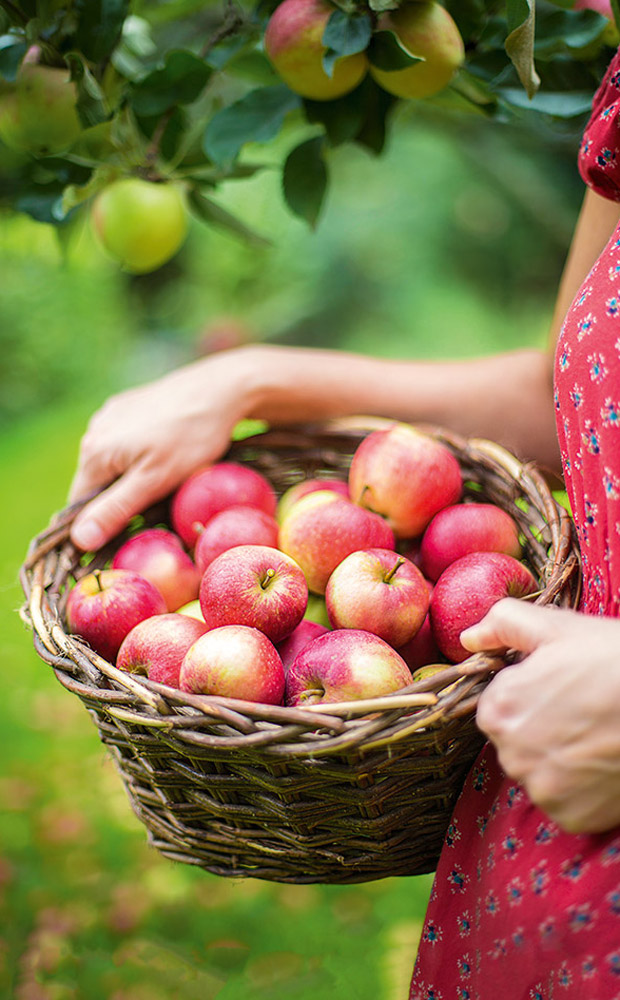
The basics of creating a productive orchard, and the design tricks that will keep it that way.
Words: Sheryn Dean
There are all sorts of philosophies you can follow when it comes to creating a perfect orchard, including food forestry, permaculture and productive.
They all incorporate similar practices, fruit trees, edible perennial and annual vegetables and herbs, and beneficial flowers growing organically in an attractive landscape. I class my orchard as productive, a mix of experiments and experience I’ve gathered over the last 20-odd years.
If you want a productive garden that works well, the best advice I can give you is that it takes good planning.
THE BIGGER, THE BETTER
An orchard always looks like a ridiculously open, sparse space at first. But it’s crucial for trees and their spreading root systems to have plenty of room. Tree roots keep growing, seeking nutrients and water until they come across opposition such as rocks, a driveway, a building, or another tree.

The space you give them is the powerhouse of your orchard, fed, nurtured, and insulated by a good understorey. Large trees can have roots extending over 120m from the trunk, not – as many people think – just as far as the dripline.
Sheryn’s tip: Future proof
You’ll always find an exciting new variety to add to your orchard, so leave some extra space to allow for new additions.
GIVE TREES PLENTY OF ROOM
Temperate-climate plants such as apples, plums, and peaches need light and space around them for maximum production. Sunlight (via photosynthesis) creates energy, and an open, clear area gives plenty of room for roots to anchor into the soil.
When you look at a nursery catalogue, it should include how high the tree will get (often at five years and maturity), and how broad its crown will be. You then need to allow at least a metre of clear space between the crowns of neighbouring trees.
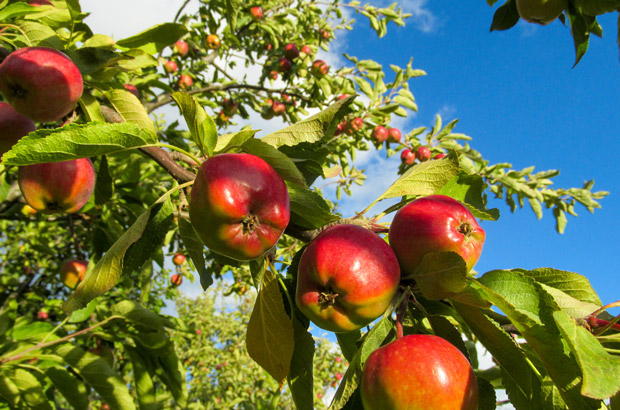
The exceptions are tropical plants from jungle environments, such as bananas, tamarillos, choko etc, which benefit from close interplanting. But generally, give everything else lots of room to grow for optimum production.
Sheryn’s tip: Trees that get big do better
Big trees are more robust and need a lot less maintenance than trees on dwarfing rootstock or those pruned to a smaller size.

The bigger the tree, the bigger its roots and crown, the more it photosynthesises sunlight, the more nutrients it takes up, the healthier it is, and the more fruit it produces.
CREATE A CORRIDOR
You may want to drive a tractor, ATV, or a ute through your orchard to help bring in mulch or take out firewood. If so, you need at least a 2-3m wide corridor between the widest part of the crowns of trees along its edge.
This leaves a lot of understorey that needs to be maintained. Grazing sheep is an option, but you must protect each plant, so people often mow around them instead. If you think you’re likely to mow, imagine your plants fully grown.
Can you get a mower between the trees and around other obstacles? The best machine is a zero-turn model with a deck sitting at the front. It’s easy to mow up to the trunk without getting clobbered, and to get in and out of tight spots.
Sheryn’s tip: Measure & mark
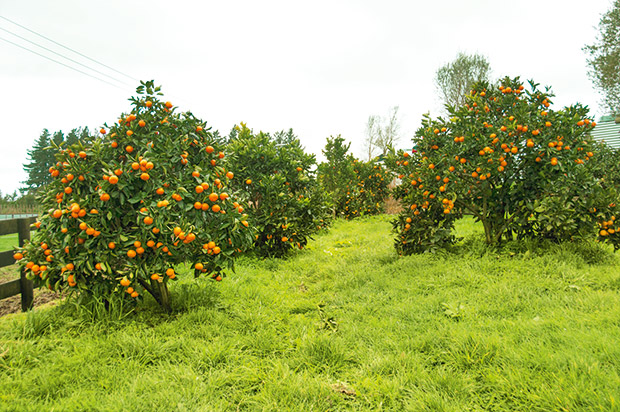
Check how easy it will be to move through your orchard. Use a measuring tape to get spacings right. Electric fence standards (pigtails) or sticks can mark each tree trunk. Run the lawnmower around each one to simulate the crown width, and create corridors using electrical tape.
GET IN THE ZONE
I prefer planting similar trees with similar harvesting times in groups. It improves cross-pollination, which benefits even self-fertile varieties, and each week’s harvest is focused on that one area.
It sounds strange, but it’s easy to miss a harvest. You watch a tree growing its fruit, then you get busy for a week. In that time, the fruit has ripened, dropped, and been consumed by birds, possums, and rats.
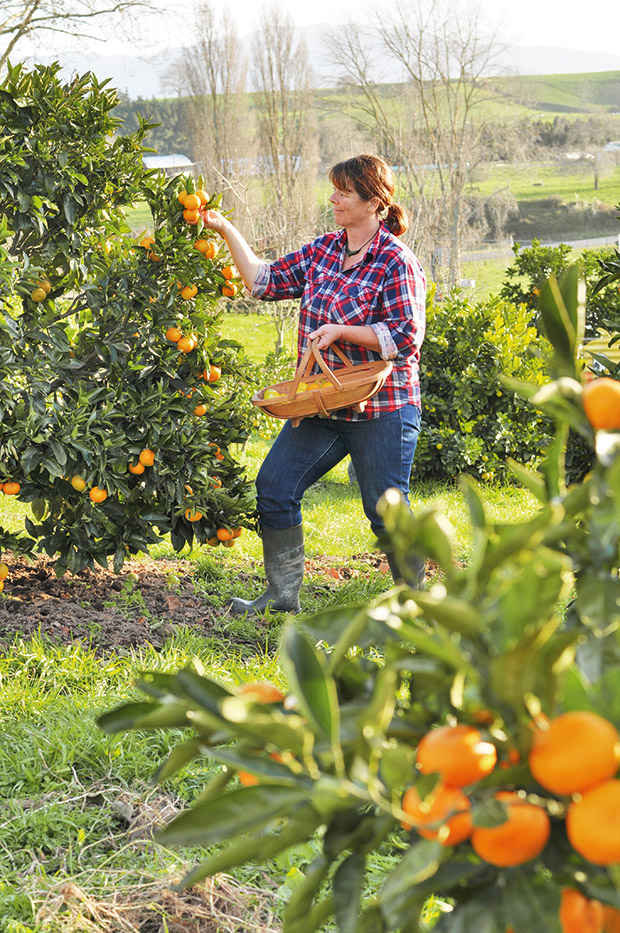
Having all your citrus in one area, peaches and nectarines in another, early apples with other earlies etc, means you can focus on what’s in season and ignore the rest. It also means you can concentrate pruning efforts or pest control in that one zone.
There is an argument that pests and disease will spread if all their favourite things are in one spot, and similar trees should be widely spaced to prevent it. However, I’ve found pests (and disease) will happily migrate over a wide area (in my case, at least 60m in a year), so the benefits of zoning outweighed this aspect.
PLANT TO MATCH YOUR MICROCLIMATES
Even a small, flat orchard will have differences in climate. One side will get the prevailing wind, another more sun. Dips and hollows are naturally damper and colder.
You need to tailor your plantings to get the best out of your climate zones.
In regions that suffer from fungal diseases (Auckland, Waikato), plant susceptible peaches and nectarines in a breezy spot to help prevent brown rot and leaf curl.
Plant figs and persimmons in damper areas. However, fig roots are very invasive, so don’t plant them near wastewater systems.
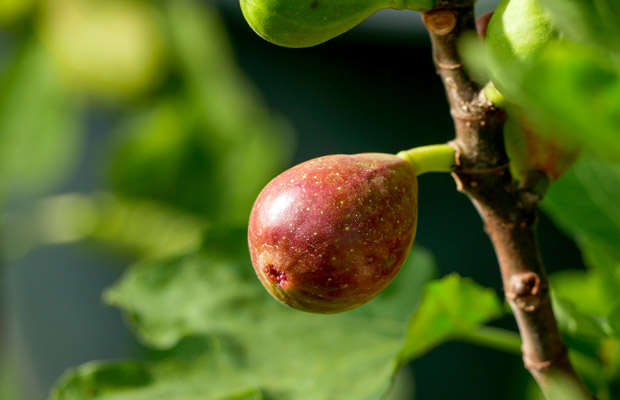
Avocadoes can get phytophthora if their roots stay damp, so plant them on a rise. If you don’t have a high area, create one using a large tractor tyre filled with soil.
Feijoas make great shelterbelts. I also used my Japanese plums as a shelterbelt in a medium wind zone. Even in bad years, I still got loads of fruit.
Apricots and cherries that need winter chill need to be on the lowest ground, where cold air sits.
Citrus does best in the sunniest, hottest areas.
Tamarillos and other subtropical trees like to be up against a heat sink such as a water tank or a wall.
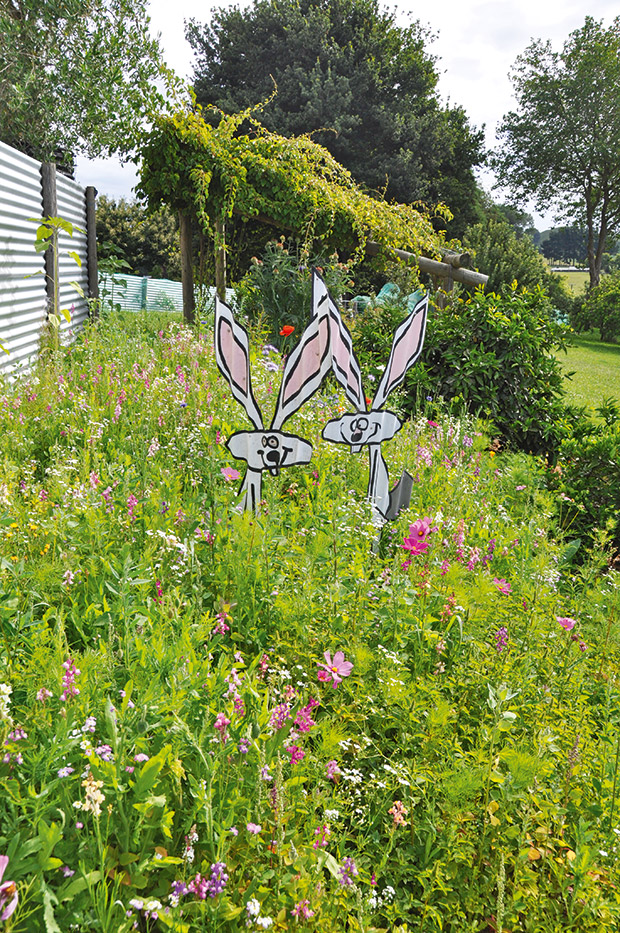
PLANNING WATER LINES
Once you have a design, but before you plant, install water lines. I don’t recommend regular watering of trees, but it’s always convenient to have a hose nearby.
Sheryn’s tip: The best place to run water pipes
I tie water pipes to the lower part of the fence. That way, you always know where they are, and they’re visible (no accidental mowing or cutting through it with a spade). It’s also easy to splice in a new tap, rather than digging it up.
9 WAYS TO MAKE YOUR ORCHARD A MINDFUL HAPPY PLACE
Don’t think of an orchard as ugly row after ugly row of trees. Have it very close to, or even around your home. Don’t hide it out the back and visit it on a monthly basis as it isn’t going to work.
I’ve found it’s crucial to make it a space that you want to be in, every day, so you can keep an eye on what’s ripening, and what needs attention.
1. Incorporate a play area for children, your chicken coop, the worm farm.
2. Position it so it’s a pleasant alternative route to the letterbox.
3. Plan secluded nooks so you can lie under the trees when they’re heavy with blossom.
4. Create a seated area so you can sit among the citrus and appreciate their scent.
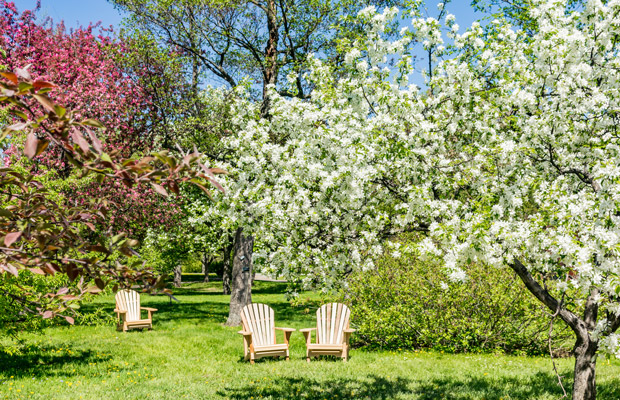
5. Structures such as pagodas can support grapevines.
6. Create hedges using ‘tea’ camellias (Camellia sinensis), or Ugni molinae (NZ cranberry, evergreen, pretty pink flowers, gorgeous red berries).
7. Put in a water feature for birds and insects.
8. Plant quinces, persimmons, and crabapples in prominent positions close to the house – they all give stunning shows of flowers and fruit.
9. Citrus looks lovely all year round – you can even trim them into topiary shapes if you want them to look formal.
WHY SHERYN’S ORCHARD IS HER WHOLE BLOCK
Sheryn’s ‘orchard’ covers her entire block. While there is a main orchard close to the house, many of the trees are in paddocks running alongside the driveway so it’s a nice walk to the letterbox.

THE DESIGN FEATURES THAT DIDN’T WORK FOR ME
I laid out my productive garden in clusters and shapes according to an easy lawnmowing route. When the trees were young, I created beds of wildflowers between each group, added in vegetable gardens, and heavily mulched around each tree.
The wildflowers needed a lot of attention and I didn’t want to spray when it was time to resow them. They look wonderful, and I recommend planting them if you have a big, bare area of soil, but I don’t think of them as a long-term prospect as they were just so much work.
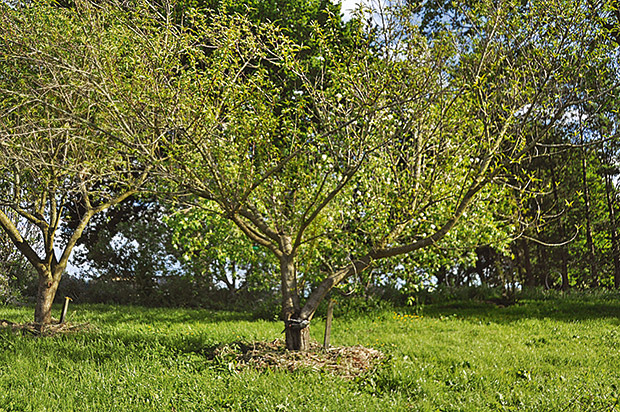
The vegetable garden didn’t work long-term either. The digging, weeding, and root competition definitely affected the roots of the fruit trees. Even a heavily-fed, no-dig asparagus crop under the pear tree was detrimental to both. Eventually, I created a designated vegetable garden away from the shade and competition of trees.
I underestimated how much room I’d need between the citrus and boundary fence. It meant mulching between them had to be abandoned. Couch grass (also known as twitch) kept growing through the mulch no matter how thickly it was applied or how often I weeded it. It was easier to control it with the lawnmower.
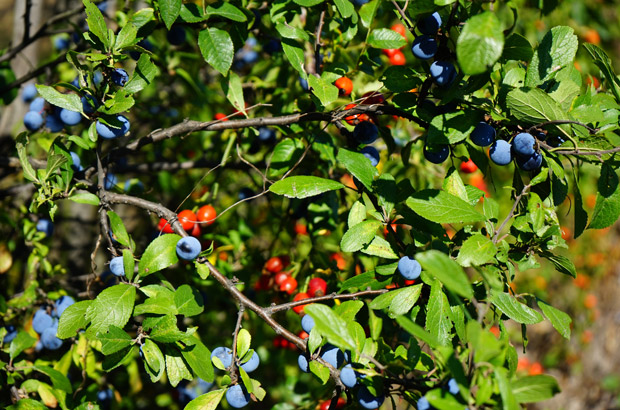
One thing that did work well over the long-term was bulbs under the plum trees. The bulbs were happy to flower, and I didn’t have to mow that area until autumn.
3 PLANNING TIPS IF YOU’RE PLANTING THIS WINTER
Deciduous trees are best planted mid-winter, and frost-tender evergreens in spring.
1. Start with a soil test so you can adjust major imbalances, especially pH, before you start planting (July-September).
2. You’ll want about half a cubic metre of compost per tree so start preparing this now. Gather compost materials from wherever you can.
Ask friends for their green waste and neighbouring farmers for any old hay, silage or bedding chips they don’t want. However, be vigilant with biosecurity if you’re importing composting materials.
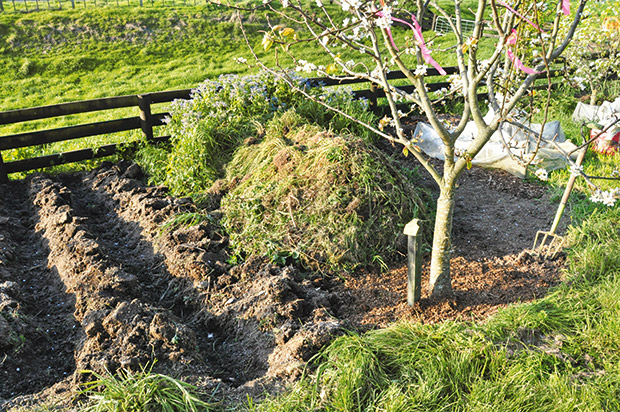
You don’t want:
– anything that contains noxious weeds.
– bedding woodchip that may have been sprayed with antibacterial disinfectant;
– grass sprayed with glyphosate (some farmers do this before harvesting for silage).
– horse manure that contains drench
– if a poo pile is full of active worms, it should be fine.
3. If you already have grass in your orchard area, simply let it grow. When it’s mowed, or it falls over due to old age, it will rot down and feed the soil.
MORE HERE
Love this story? Subscribe now!
 This article first appeared in NZ Lifestyle Block Magazine.
This article first appeared in NZ Lifestyle Block Magazine.
